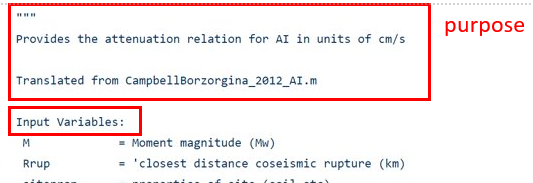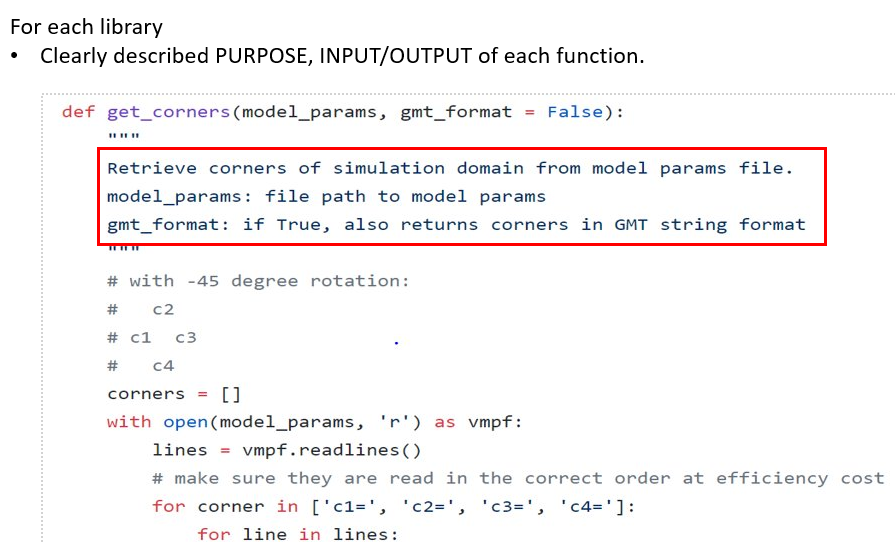...
| Code Block |
|---|
""" Command to run this test: 'python -m pytest -v -s test_srf.py'
To know the code coverage : py.test --cov=test_srf.py
To know the test coverage :python -m pytest --cov ../../srf.py test_srf.py
"""
from qcore import srf, shared
import pytest
from datetime import datetime
import os
import numpy as np
import sys
import getpass
import shutil
import errno
ERROR_LIMIT = 0.001
SRF_1_PATH = os.path.join(os.path.abspath(os.path.dirname(__file__)), "sample1/input/Hossack_HYP01-01_S1244.srf")
SRF_2_PATH = os.path.join(os.path.abspath(os.path.dirname(__file__)), "sample2/input/Tuakana13_HYP01-01_S1244.srf")
SRF_3_PATH = os.path.join(os.path.abspath(os.path.dirname(__file__)), "sample3/input/single_point_source.srf")# This is a fake one, just created for testing single point source
SRF_1_CNR_PATH = os.path.join(os.path.abspath(os.path.dirname(__file__)), "sample1/output/cnrs.txt")
SRF_2_CNR_PATH = os.path.join(os.path.abspath(os.path.dirname(__file__)), "sample2/output/cnrs.txt")
SRF_1_OUT_ARRAY_SRF2LLV = os.path.join(os.path.abspath(os.path.dirname(__file__)), "sample1/output/out_array_srf2llv.bin")
SRF_2_OUT_ARRAY_SRF2LLV = os.path.join(os.path.abspath(os.path.dirname(__file__)), "sample2/output/out_array_srf2llv.bin")
SRF_1_OUT_ARRAY_SRF2LLV_PY = os.path.join(os.path.abspath(os.path.dirname(__file__)), "sample1/output/out_array_srf2llv_py.bin")
SRF_2_OUT_ARRAY_SRF2LLV_PY = os.path.join(os.path.abspath(os.path.dirname(__file__)), "sample2/output/out_array_srf2llv_py.bin")
SRF_1_PLANES = srf.read_header(SRF_1_PATH, True)
SRF_2_PLANES = srf.read_header(SRF_2_PATH, True)
HEADERS = ['centre', 'nstrike', 'ndip', 'length', 'width', 'strike', 'dip', 'dtop', 'shyp', 'dhyp']
DIR_NAME = (os.path.join("/home/",getpass.getuser(),("tmp_" + os.path.basename(__file__)[:-3] + '_' + ''.join(str(datetime.now()).split())).replace('.', '_')).replace(':', '_'))
def setup_module(scope="module"):
""" create a tmp directory for storing output from test"""
print "----------setup_module----------"
try:
os.mkdir(DIR_NAME)
except OSError as e:
if e.errno != errno.EEXIST:
raise
def teardown_module():
""" delete the tmp directory if it is empty"""
print "---------teardown_module------------"
if len(os.listdir(DIR_NAME)) == 0:
try:
shutil.rmtree(DIR_NAME)
except (IOError, OSError) as (e):
sys.exit(e)
@pytest.mark.parametrize("plane, expected_values",[( SRF_1_PLANES[0], [[176.2354,-38.3404], 34, 92, 3.44, 9.24, 230, 60, 0.00, 0.00, 5.54]),
(SRF_2_PLANES[0],[[176.8003, -37.0990], 46, 104, 4.57, 10.44, 21, 50, 0.00, 0.00, 6.27]),
(SRF_2_PLANES[1], [[176.8263, -37.0622], 49, 104, 4.89, 10.44, 37, 50, 0.00, -999.90, -999.90])])
def test_plane(plane, expected_values):
""" Tests for the header lines """
for i in xrange(len(HEADERS)):
assert(plane[HEADERS[i]] == expected_values[i])
@pytest.mark.parametrize("test_dt, expected_dt", [(SRF_1_PATH, 2.50000e-02),
(SRF_2_PATH, 2.50000e-02), ])
def test_dt(test_dt, expected_dt):
assert srf.srf_dt(test_dt) == expected_dt
@pytest.mark.parametrize("test_dxy, expected_dxy",[(SRF_1_PATH, (0.10,0.10)),
(SRF_2_PATH,(0.1,0.10)),])
def test_dxy(test_dxy, expected_dxy):
assert srf.srf_dxy(test_dxy) == expected_dxy
@pytest.mark.parametrize("test_srf,filename,sample_cnr_file_path",[(SRF_1_PATH,'cnrs1.txt',SRF_1_CNR_PATH), (SRF_2_PATH,'cnrs2.txt',SRF_2_CNR_PATH)])
def test_srf2corners(test_srf,filename,sample_cnr_file_path):
# NOTE : The testing was carried out based on the assumption that the hypocentre was correct
# srf.srf2corners method calls the get_hypo method inside it, which gives the hypocentre value
abs_filename = os.path.join(DIR_NAME,filename)
print "abs_filename: ",abs_filename
srf.srf2corners(test_srf,cnrs=abs_filename)
out, err = shared.exe("diff -qr " + sample_cnr_file_path + " " + abs_filename)
assert out == "" and err == ""
try:
os.remove(abs_filename)
except (IOError, OSError):
raise
@pytest.mark.parametrize("test_srf,expected_latlondepth",[(SRF_1_PATH, {'lat': -38.3354, 'depth': 0.0431, 'lon': 176.2414}),\
(SRF_2_PATH, {'lat': -37.1105, 'depth': 0.0381, 'lon': 176.7958}
)])
def test_read_latlondepth(test_srf,expected_latlondepth): #give you so many lat,lon,depth points
points = srf.read_latlondepth(test_srf)
assert points[9] == expected_latlondepth # 10th point in the srf file
@pytest.mark.parametrize("test_srf,seg,depth,expected_bounds",[(SRF_1_PATH, -1, True,[[(176.2493, -38.3301, 0.0431), (176.2202, -38.3495, 0.0431), (176.1814, -38.3221, 7.886), (176.2105, -38.3027, 7.886)]]
),(SRF_2_PATH, -1, True,[[(176.7922, -37.118, 0.0381), (176.8101, -37.0806, 0.0381), (176.876, -37.1089, 7.8931), (176.8581, -37.1464, 7.8931)], [(176.8107, -37.0798, 0.038), (176.8433, -37.0455, 0.038), (176.9092, -37.0739, 7.8672), (176.8765, -37.1082, 7.8672)]]), \
(SRF_1_PATH, -1, False,[[(176.2493, -38.3301), (176.2202, -38.3495), (176.1814, -38.3221), (176.2105, -38.3027)]]
),(SRF_2_PATH, -1, False,[[(176.7922, -37.118), (176.8101, -37.0806), (176.876, -37.1089), (176.8581, -37.1464)], [(176.8107, -37.0798), (176.8433, -37.0455), (176.9092, -37.0739), (176.8765, -37.1082)]]
)])
def test_get_bounds(test_srf, seg, depth, expected_bounds):
assert srf.get_bounds(test_srf, seg=seg, depth=depth) == expected_bounds
@pytest.mark.parametrize("test_srf, expected_nseg",[(SRF_1_PATH, 1),(SRF_2_PATH,2)])
def test_get_nseg(test_srf, expected_nseg):
assert srf.get_nseg(test_srf) == expected_nseg
@pytest.mark.parametrize("test_srf, expected_result",[(SRF_1_PATH, True),(SRF_2_PATH,True)])
def test_is_ff(test_srf, expected_result):
assert srf.is_ff(test_srf) == expected_result
@pytest.mark.parametrize("test_srf_planes, expected_result",[(SRF_1_PLANES, 1),(SRF_2_PLANES,2)])
def test_nplane1(test_srf_planes, expected_result):
assert len(test_srf_planes) == expected_result
@pytest.mark.parametrize("test_srf, expected_result",[(SRF_1_PATH,(AssertionError)),(SRF_2_PATH,AssertionError),(SRF_3_PATH,(0, 60, 30))])
def test_ps_params(test_srf, expected_result):
try:
srf.ps_params(test_srf)
print "point is single- in try block"
except AssertionError:
print "point is not single-except block "
return
assert srf.ps_params(test_srf) == expected_result #only check strike, dip, rake values if it is a single point source
@pytest.mark.parametrize("test_srf, sample_out_array",[(SRF_1_PATH,SRF_1_OUT_ARRAY_SRF2LLV),(SRF_2_PATH,SRF_2_OUT_ARRAY_SRF2LLV)])
def test_srf2llv(test_srf, sample_out_array):
sample_array = np.fromfile(sample_out_array, dtype='3<f4')
out_array = srf.srf2llv(test_srf)
compare_np_array(sample_array,out_array,ERROR_LIMIT)
@pytest.mark.parametrize("test_srf, sample_out_array",[(SRF_1_PATH,SRF_1_OUT_ARRAY_SRF2LLV_PY),(SRF_2_PATH,SRF_2_OUT_ARRAY_SRF2LLV_PY)],)
def test_srf2llv_py(test_srf, sample_out_array):
sample_array = np.fromfile(sample_out_array, dtype = '3<f4')
out_array_list = srf.srf2llv_py(test_srf)
print("Adsfafsaf",out_array_list)
out_array = out_array_list[0]
# out_array[0] += 1 # Use this, if you want to test for a fail case, by changing a value in the out_array
for array in out_array_list[1:]:
out_array = np.concatenate([out_array, array])
print("first out array", out_array)
compare_np_array(sample_array,out_array,ERROR_LIMIT)
def compare_np_array(array1, array2, error_limit):
"""array1: a numpy array from sample output, will be used as the denominator,
array2: a numpy array from test output, makes part of the numerator.
error_limit: preset error_limit to be compared with the relative error (array1-array2)/array1
"""
assert array1.shape == array2.shape
relative_error = np.divide((array1 - array2), array1)
print "relative_error: *********** ", relative_error
max_relative_error = np.nanmax(np.abs(relative_error))
print "max_relative_error: *********** ", max_relative_error
assert max_relative_error <= error_limit
|
4. Test Responsibility
(1) Scripts tests are conducted by a person that is not involved in the development of the script.
(2) Library tests/Unit tests are created and executed by the developer of the unit.
All Scripts and Library files must pass the tests before being accepted to the usgmsim Git repositories.
5. Scripts/Library Documentation
To make the tester's job easier and as an industry standard, every script/library should be accompanied by good comments and documents.
(1) Comments
(2) Documents
We use Sphinx to automatically generate detailed documentation on our scripts/libraries. Please follow the link below to see more details about this,
Documenting The SeisFinder2 Project




